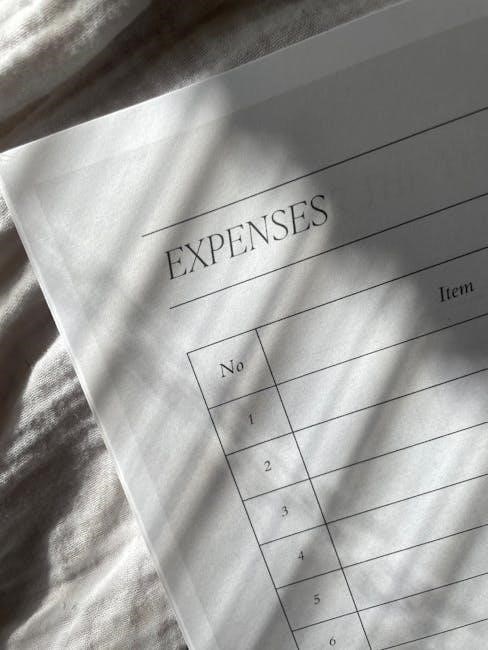Evaluating functions is a fundamental skill in algebra, enabling students to understand function notation, identify one-to-one functions, and interpret graphs effectively for accurate function evaluation and problem-solving.
1.1 Understanding Function Notation
Function notation is a way to represent functions using variables and inputs. For example, in f(x) = 2x + 3, f(x) represents the output when x is the input. This notation is essential for evaluating functions, as it clearly shows the relationship between variables. To evaluate f(a), replace x with a in the function. Practice problems and worksheets often use this notation to help students master function evaluation. Understanding function notation is the first step in working with functions effectively in algebra.
1.2 Importance of Evaluating Functions in Algebra
Evaluating functions is crucial in algebra as it helps students understand how functions operate and relate variables. By substituting values into function notation, learners can predict outcomes, model real-world situations, and solve equations. This skill is foundational for advanced topics like graphing and analyzing function behavior. Worksheets and practice problems reinforce these concepts, ensuring mastery. Proficiency in evaluating functions enhances problem-solving abilities and prepares students for more complex mathematical challenges. Regular practice with function evaluation worksheets is essential for building a strong algebraic foundation.

Types of Functions to Evaluate
Functions vary in complexity, including linear, quadratic, and absolute value functions, each requiring specific evaluation techniques. Mastering these types is essential for algebraic proficiency.
2.1 Linear Functions
Linear functions are polynomial functions of degree one, represented as f(x) = mx + b, where m is the slope and b is the y-intercept. Evaluating linear functions involves substituting input values into the function to find the corresponding output. For example, given f(x) = 2x + 3, to find f(4), replace x with 4: f(4) = 2(4) + 3 = 11. Practice problems often include multiple functions like g(x) = -x + 5 or h(t) = t/2 + 7, ensuring mastery of this foundational skill. Worksheets typically provide several functions to evaluate, reinforcing the concept.
Quadratic functions are second-degree polynomials, expressed as f(x) = ax² + bx + c. Evaluating these functions involves substituting specific values of x into the equation. For instance, given f(x) = x² ⎼ 3x + 2, to find f(4), substitute 4 for x: f(4) = 16 ‒ 12 + 2 = 6. Worksheets often include multiple quadratic functions and practice problems, such as g(x) = 2x² + 5x ⎼ 8, to help students master evaluation. These exercises are essential for understanding function behavior and preparation for more complex algebraic concepts. Absolute value functions, like f(x) = |x|, return non-negative results. To evaluate them, substitute x values. For example, f(5) = |5| = 5 and f(-1) = |-1| = 1. Worksheets include problems like g(x) = |x ‒ 3|, asking for evaluations at specific points. These exercises help students understand absolute value effects on outputs. Resources like MathWorksheetsGo offer free PDFs for practice. Mastering these functions is crucial for modeling real-world distance and magnitude scenarios. One-to-one functions ensure each input maps to a unique output. They are crucial for finding inverse functions. Use the horizontal line test to verify their uniqueness.2.2 Quadratic Functions
2.3 Absolute Value Functions

Identifying One-to-One Functions
3.1 Using the Horizontal Line Test
The horizontal line test is a visual method to determine if a function is one-to-one. By drawing horizontal lines across the graph, if any line intersects the function more than once, the function is not one-to-one. This test is essential for identifying invertible functions. It ensures that for every y-value, there is a unique x-value, maintaining the function’s uniqueness. Worksheets often include graphs for practice, helping students master this technique and apply it to various function types, including linear, quadratic, and absolute value functions. This skill is vital for advanced algebraic concepts and problem-solving.
3.2 Practice Problems for Identifying One-to-One Functions
Practice problems are essential for mastering the identification of one-to-one functions. Worksheets often include graphs and function definitions for students to analyze. For example, given f(x) = 2x + 2, students determine if it passes the horizontal line test. Free PDF resources, like those from MathWorksheetsGo and Kuta Software, provide diverse exercises. These problems cover linear, quadratic, and absolute value functions, ensuring comprehensive understanding. By solving these, students refine their ability to apply the horizontal line test and recognize one-to-one functions, a skill crucial for inverse functions and real-world applications.

Evaluating Functions from Graphs
Evaluating functions from graphs involves understanding the vertical line test and accurately interpreting visual data to find specific function values, supported by free PDF practice worksheets.
4.1 Understanding the Vertical Line Test
The vertical line test is a crucial method to determine if a relation is a function. By drawing a vertical line across the graph, it should intersect at most one point. This ensures that each x-value corresponds to a single y-value, confirming the relation as a function. The test is essential for identifying one-to-one functions, which are invertible. Practice worksheets often include exercises where students apply this test to various graphs, reinforcing their understanding of function evaluation and equation solving in function notation. This skill is fundamental for advanced algebraic concepts and problem-solving.
4.2 Interpreting Graphs to Find Function Values
Interpreting graphs is a key skill for evaluating functions. By analyzing the graph, you can identify specific function values by locating the y-value corresponding to a given x-value. This involves plotting points and reading coordinates accurately. Practice worksheets often include exercises where students interpret graphs to find values like f(-3) or g(5). This skill is essential for solving equations in function notation and understanding one-to-one functions. Using graphs helps verify results and avoid common mistakes in function evaluation, ensuring accurate and reliable outcomes in algebraic problem-solving. Regular practice with worksheets enhances this ability significantly.
Practice Problems and Worksheets
Enhance your understanding with practice problems and worksheets, offering exercises to evaluate functions, interpret graphs, and solve equations in function notation accurately.
5.1 Sample Problems for Evaluating Functions
Sample problems provide hands-on practice in evaluating functions at specific points. For example:
- Finding ( g(-1) ) for ( g(x) = 3x + 2 ).
- Evaluating ( f(-3) ) for ( f(x) = 2x ‒ 4 ).
- Determining ( h(6) ) for ( h(t) = t/2 + 3 ).
These exercises reinforce understanding of function notation and input-output relationships, ensuring accurate evaluation skills. They also cover various function types, including linear, quadratic, and absolute value functions. Regular practice with these problems helps build confidence and fluency in algebraic manipulation and interpretation.
5.2 Free PDF Worksheets for Practice
Free PDF worksheets are an excellent resource for practicing function evaluation. Websites like Kuta Software and MathWorksheetsGo offer customizable worksheets covering various function types, such as linear, quadratic, and absolute value functions. These PDFs provide sample problems, step-by-step solutions, and exercises to reinforce understanding. Many worksheets are printable, making them ideal for homework or classwork. They also include answer keys for self-assessment, helping students identify areas for improvement. Utilizing these resources ensures comprehensive practice and mastery of function notation and evaluation skills. Regular use of such worksheets enhances problem-solving abilities and algebraic fluency.
Solving Equations in Function Notation
Solving equations in function notation involves substituting values and manipulating expressions. For example, given ( g(x) = x^2 ‒ 5x ⎼ 2 ), find ( g(3) ) or solve ( g(x) = 0 ).
6.1 Step-by-Step Solutions
Step-by-step solutions for equations in function notation involve substituting values and solving for unknowns. For example, given ( g(x) = x^2 ‒ 5x ‒ 2 ), to find ( g(3) ), substitute 3 into the function:
- Substitute: ( g(3) = (3)^2 ‒ 5(3) ⎼ 2 )
- Simplify: ( g(3) = 9 ⎼ 15 ⎼ 2 )
- Calculate: ( g(3) = -8 )
Practice worksheets provide exercises like solving ( f(x) = 2x + 1 ) for ( f(4) ) or finding roots by setting ( f(x) = 0 ) and solving for ( x ). This method ensures clarity and accuracy in problem-solving.
6.2 Common Mistakes to Avoid
When solving equations in function notation, common mistakes include misapplying order of operations and incorrectly substituting values. For instance, in ( f(x) = 3x + 2 ), substituting ( x = 4 ) should yield ( f(4) = 14 ), not ( 12 ). Another error is confusing function notation with standard equations, such as misinterpreting ( f(x) = 0 ) as setting the entire function to zero. Additionally, students often overlook negative signs and mismanage exponents, leading to incorrect results. Regular practice with worksheets helps identify and correct these errors, improving overall accuracy.

Tips for Accurate Function Evaluation
Always verify each step to avoid calculation errors. Use graphing calculators or online tools to confirm results. Break down complex functions into simpler parts for clarity. Pay attention to negative signs and parentheses to ensure accuracy. Regular practice helps build familiarity and confidence in evaluating functions effectively.
7.1 Checking Your Work
Checking your work is essential for accuracy when evaluating functions. Start by substituting the input value back into the function to verify the result. Use graphing calculators or online tools to confirm your answers. Review each step for calculation errors, especially signs and exponent handling. Practice with worksheets and compare your solutions to the provided answer keys. Reflect on common mistakes, such as misapplying function notation or ignoring absolute value rules. Regular self-assessment builds confidence and improves problem-solving skills in evaluating functions effectively.
7.2 Using Technology to Verify Results
Technology is a valuable tool for verifying function evaluation results. Graphing calculators and online platforms like Desmos or GeoGebra allow users to input functions and check outputs instantly. Additionally, free PDF worksheets provide practice problems that can be solved manually and then verified using digital tools. Software like Mathway or Wolfram Alpha can also solve equations step-by-step, ensuring accuracy. By combining traditional problem-solving with technology, students can identify errors, improve efficiency, and gain confidence in their ability to evaluate functions correctly.
Evaluating functions is a cornerstone of algebra, essential for understanding function notation, identifying one-to-one functions, and interpreting graphs. Through practice problems and worksheets, students can master these skills, ensuring accuracy and confidence. Utilizing tools like graphing calculators and online platforms enhances learning, while free PDF resources provide ample opportunities for reinforcement. By consistently applying these strategies, learners can deepen their mathematical proficiency and tackle more complex challenges with ease. The journey from basic function evaluation to advanced problem-solving is streamlined with the right resources and dedication;
